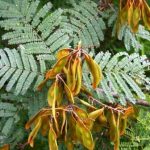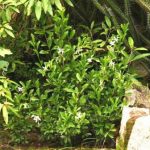TREE LIFE
April 1993
A reminder that subscriptions are now due for 1993/94 and we would appreciate your payment ($20) before 30th May 1993
MASHONALAND CALENDAR
Tuesday 6th April : Botanic Garden at 1645 hours for 1700 hours. Park at the Herbarium where we will meet Tom Muller.
Sunday18th April : Highbury Estates – Mhangura Area
We have not been to the Mhangura area for a long time, so a visit to Highbury Estates should be interesting. Incidentally the name Mhangura means “copper”. Highbury Estates is owned by Zimcor Ltd. and our hosts will be Mike and Jenny Gibson. Included in the day’s plan will be a walk up a kopje to see several lowveld tree species including masses of Sterculia quinqueloba. The remains of some old fortifications are also on the kopje. After lunch Jeremy Gibson will show us her cottage industry, candles and candlesticks and so on, some of which will be for sale. Bring you cheque books if interested.
Tuesday 4th May : Botanic Garden Walk
Sunday 16th May : A.G.M. at Jill and John Marr-Levin. Goromonzi
MATABELELANDCALENDAR
Senday 4th April : 11..G.M. at Cyrene and this will be an all day Visit. Members requiring lifts please contact Ian or Margaret McCausland (home 41945). Rendezvous at Girls‘ College car park off Pauling Road in Suburbs. Cars may be left within the security fence and under guard for the whole day. In the morning we will visit Fort Marquand and then take an early lunch at Cyrene. Those who are interested may visit its well known church (St. Pancreas) The A.G.M. will be held after lunch and then on to Fort Molyneux and finally to the figtree of Figtree. Alison Ewbankk an expert on the area will lead us.
Monday 5th April : Urban Trails. Meet at Hillside Dams at 1645 hours for 1700 hours.
Sunday 2nd May : A morning visit to Leopard Rock Kopje on the Khami Waterworks Road.
Monday 3rd May : Urban Trails
BOTANIC GARDEN WALK : 2 MARCH 1993
In preparation for the Tree Society’s visit to Nyanga over Easter, Tom kindly led us into the Eastern Highlands section of the Garden to examine the trees of the high rainfall forests. It is hoped, on the Nyanga trip, to visit Nyasengu, a privately-owned piece of land which includes port of Mount Nyangani.
On the walk we were pleased to have a visitor Mike Bingham, a well-known plant expert and collector from Zambia.
So many species were seen it is impossible to cover them all. This article mentions a few of the interesting features.
Our first stop was at Azfrocrania volkensii, which belongs to the CORNACEAE and, indeed, does somewhat resemble a Cornus itself, perhaps because of the depressed curling veins on the upper surface of the leaf.
In the moist shade, we saw Piper capensis, reputedly one of Kim’s favourite trees, with its swollen “arthritic“ joints and spikes of white flowers. Tom explained that this tree was common in high-a1titude moist forests. Another tree, which surprisingly occurs in these forests is Pittosporum viridiflorum, which is also well known to us all as a tree of granite outcrops on the highveld.
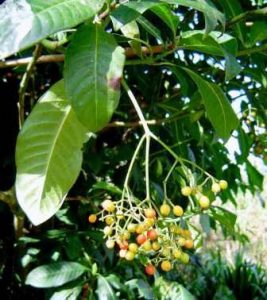
Psychotria zombamontana. Photo: Bart Wursten. Source: Flora of Zimbabwe
Nearby were two common under storey shrubs – Peddiea africana and Psychotria zombamontana, both of which Tom said should be common at Nyanga. The Peddiea was rather discreetly displaying an umbel of green flowers. It belongs to the family Thymeleaceae, the same as Daphne and Dais. The Psychotria has fairly large glossy leaves and is one of the RUBIACEAE.
Which tree has a slash which makes you think of breakfast ? The answer is Rapanea melanophloeos (the Cape Beech) which Tom says has a slash like streaky bacon. Some bits are fatter than others, others more lean.
An unusual plant which Tom is growing is Syzygium masukuense, a species of high altitudes at Nyanga. The specimen we saw was not happy in the Gardens – perhaps due to some chemical deficiency.
At the forest edge grew Macaranga mellifera (EUPHORBIACEAE) with its scarcely peltate. leaves. Another species of the forest edge is Schefflera umbellifera with its compound pelmate leaves.
In the more scrubby section out of the forest at the top we saw two characteristic Nyanga shrubs, Leucosidea sericeaa and Stoebe vulgaris. The latter and Cliffortia both have an “cricoid” appearance, although they are not related – Stoebe being a composite and Clifffortia a genus in the ROSACEAE perhaps a case of parallel evolution.
After 6 p.m. and we were into “injury time” .
As we returned to the herbarium we were shown Buddleia pulchella which is rarely seen in the wild, and Hypericum revolutum which may form thickets at 2000m.
Once again, our grateful thanks to Tom for giving up his time for the Tree Society.
-M.A.Hyde
MATABELELAND BRANCH : VISIT TO AMALINDA
Sunday dawned cool and cloudy for our visit to Amalinda, situated some 45 km from Bulawayo on the Kezi road, in a very beautiful setting in the north western Matopos.
Dave Bennet, our host, had asked for an idea of numbers, always difficult to predict, but a general phone—around produced a probable 32 and an actual 38 on the day. Dave had cleared a trail through the woodland on the rocky hillside. Our task was to identifiy the trees on the verges, with such large numbers, it was suggested that we should split into smaller groups, two to identify and label the trees, one to accompany Thora and Joy to focus on a limited number of species to learn something of their characteristics and a fourth to wander further afield with Val and Gay.
The camp is built on the side of a granite kopje at varying levels, screened from view by the natural vegetation and designed to blend into the surroundings. The open fronted bar/lounge area offers a magnificent view across the tree tops to the grasslands and hills in the distance.
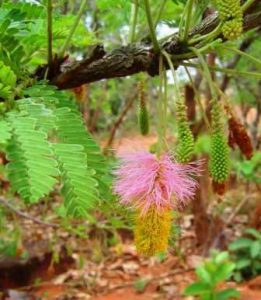
Dichrostachys cinerea subs africana. Photo: Bart Wursten. Source: Flora of Zimbabwe
Our path lead us through a grove of Commiphoras, mainly schimperi with mollis and marlothii interspersed, and a few metres up the hill, an iron-age kiln, almost intact. There were occasional specimens of Commiphora mossambicensis, numerous Pavetta eylesii, two young Lonchocarpus capassa, two Turraea fischeri (found only in the Matopos), Ficus abutilifolia, cordata, glumosa and ingens one and some magnificent Kirkia acuminata the camp within the came site and along the trail. It was of interest to see Markhamia zanzibarica; and Dichrostachys cinerea subs africana and subs nysana growing close together. As we moved into the wooded grassland area Terminalia sericea and the Combretums proliferated. One young Steganotaenia araliacea was pushing its way up through a Terminalia.
The track re-entered the woodland as it turned towards the camp. Fortunately Geoff and Clem’s group were keeping a check on the Mccausland’s numbering and were quick to pick up Terminalia trichopoda as having been mis-numbered as Teclea triohocargal
After a relaxed lunch break we labelled the trees within the campsite. The feedback which we have received is that people thoroughly enjoyed the outing and our phone calls were much appreciated. (To those who never received any, it wasn’t for wont of trying!)
Thanks to Dave and Linda for making the day possible.
-Margaret McCausland
SANGANAYI CREEK
Sanganayi Creek is a Scripture Union retreat and is situated between two creeks feeding Mazvikadei Dam . It is a very interesting area (botanically speaking) with some 58 tree and succulent species being noted.
More than sixty members and mates wandered around the main complex and commenced “treeing” on a termite mound at the edge of the car park. On this anthill Cordia sinensis, C.mollis and a single Euphorbia ingens competed for space and sunlight. Orange fruited Diospyros lycioides appeared throughout this tangle of branches and leaves as it too competed for its share of sunlight. Grewia monticola with its strange lobed trunk slithered its way around an Azanza garkeana growing at the base of the anthill. In years past before the development of the lake and its environs many hot fires must have raced through this area as several Diospyros displayed blackened bark.
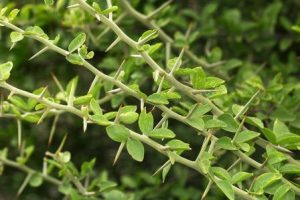
Balanites aegyptiaca. Photo: Bart Wursten. Source: Flora of Zimbabwe
Away from the main camp, Balanites aegyptiaca frequently occurred and some enormous ones grew near the workshop. Apparently a correctly cured and dethorned Balanites sapling makes a good teachers cane . . . (this is for you Cheryl!). The appearance of an unusual Pterocarpus with extra pairs of leaflets resulted in a quick reference to CP, with the answer being the sub species P.rotundifolius sp. polyanthus. A swallow tailed butterfly then flitted its way through the group to land on a Zanthoxylum chalybeum, easily identifiable as its citrus smell was most pronounced.
When we saw some Combretum molle, Phil reminded us of one of Kim’s classic stories about the use of its leaves as a substitute for toilet paper . . . perhaps taking ESAP a little too for! Acacia goetzii occurred and luckily enough both subspecies were represented. A.goetzii sp. goetzii with leaflets resembling an Acacia nigrescens only about a quarter of the size. A.goetzii sp. microphylla had the more normal pinnate leaf with considerably more pairs of leaflets than the first sub-species examined.
Another termite mound appeared on which was a bush with nasty little thorns which, ripped at one’s flesh, it was quickly identified as a Capparis tormentosa.
By now most people were covertly eyeing their watches and with the prospect of lunch drawing closer, everyone converged on the car park, some to stay at Sanganayi, the others to drive to the Curedon’s plot at Gold Dust Township.The Curedons have a really superb holiday home looking out over the lake. It was very pleasant to stretch out on the lush green lawns and attend to the lunch box and tea thermos. As an added “bonsella” Monotes glaber and M.engleri grew right next to our lunch spot but with the appearance of chocolate biscuits arboreal interest drained away.
After lunch lables were attached or rather hammered (ouch!) to various indigenous trees in the Curedon’s Garden. A large beehive camoflaged within the tentacles of a parasitic Loranthus meant business, so we proceeded with care! Another interesting feature in the garden was a couple of young Sterculia quinqueloba growing next to the plot boundary – what a magnificent sight they will be when mature.
Very many thanks to Des and Marion for inviting us to their super home and for their warm hospitality .
-Hansel
NYARUPINDA CATCHMENT : MARCH 1993
The Scene There have been only 3 dry days since the last ‘Catchment’ dated February 7th. The water in the Nyarupinda dam is lapping the sill of the spillway, any moment it will be full, what a wonderful expanse of water, we had forgotten what it looks like. Streams and gullies at the roadside are flowing; one source of water began with two minute natural mole drains in the cut away bank, close-by, exposed tree roots provided a ruler to probe how far these went into the ‘hillside!‘ If only the grandchildren had been with me, they would have enjoyed this investigation. Doubtless the little drains were made by the tree roots which had subsequently decayed. This observation showed why woody vegetation should never be allowed to grow on dam walls; the best protection for these earthworks is grass, kept short so as to be able to spot trouble as soon as it occurs e. g. tree seedlings, erosion, leaks, termite mounds, paths etc.
Msasa farm on the top lands east or the Great Dyke was the venue for the Sunday outing in February, there was plenty of interesting botanising to do along the vlei margin and adjoining stoney slopes which had squelchy patches. We compared the growth habit and leaves of three species of Protea. P.angloensis has broad plump foliage with translucent margins; P.welwitschii woolly when young but less hairy later; P.gaguedi has close-ranked narrow curved leaves. Their flowering periods are spaced throughout the year, beginning with P.welwitschii etc. then P.angolensis in June and July followed by P.gaguedi during spring and early summer. The latter strange specific name was Ethiopian vernacular but later another botanist called it P.abyssinca. The first name prevailed because of the rule of priority. Thus it was not the discovery of a “Mister” Gagued, a likely explanation.
Tree Society members and friends gathered around when Kenneth Haxen displayed a Painted Reed Frog which he found at the dam site, this species was mentioned in a recent “Tree Life”, then someone mentioned they had heard it on an audio tape called “Nature’s Melody” . The smaller the frog the higher the pitch of its voice, this made us laugh.
Almost the last tree we noticed was a dense low clump of water fig Ficus verruculosa, a ‘bright spark’ turned over one leaf to show us the warts, it will be remembered, provided that there are some leaves with verrucas.
A Let Down
Brewer’s Dictionary of Phrase and Fable” 1975 impression does not include “Touch Wood” for good luck, can you find or do you know the origin of this phrase?
Spin off
As a result of the vagaries of the weather during the past six months, (extreme drought, high temperatures, gales and the inevitable veld fires and more recently violent electrical storms, downpours and driving rain have brought cooler, conditions generally and waterlogging of some types of soil) some trees have died, examples in the catchment are a few Proteas, Terminalia mollis and Uapaca kirkiana there are more but not easy to remember. Collectors of woodfuel are everywhere hooking down dry branches. Damaged trees are a source for the collector of samples eg the Msasa day yielded self prunings of Elephantorrhiza goetzei, their diameter was small but will suffice until better specimens are found; these remnants often have the advantage of being seasoned and ready to be trimmed to place in the sequence of the National Tree list.
Another consequence of the weather has been the need for more dams. When these are made the basin is cleared for the machines, this is the time to be there with permission to select specimens for a display of wood.
In 1977 the labourers c1earing ground for damning the Nyarupinda riverwere instructed to cut 12 different kinds of trees, a label with the name was tied to each, they were as follows
- Mutsonzow Duikerberry tree.
- Mupembere Velvet leaved Combretum
- Muchechere Buffalo thorn
- Muremberembe Longpod Cassia
- Mutsvirikiti Red Star-apple
- Muzeze African wattle
- Mutuktutu Monkey bread tree
- Mutsatsati Broad-leaved beechwood
- Mutowa Rubber tree
10.Mubayamhandoro Acacia with pale coloured straight thorns (spines) A.sieberiana
- Mususu Silky leaved Terminalia
- Muunga Acacia with pale coloured straight thorns (spines)
Some after thoughts about household words.
The versatile timber called Meranti belongs to DIPTEROCARPACEAE along with the genus Manotes. Its name is Shorea sp. it is indigenous to Sri Lanka.
Sapele mahogany is truly mahogany since it belongs to MELIACEAE. It is none other than the wooden banana tree Entandophragma caudatum. Rosewood (Indian) is likely to be .
Now what is Imbuya /Imbuia. ? In my ‘1ibrarinth’ (that means the state of the room after the completion of a contribution to “Tree Life”) the meaning of this word cannot be found, it is not even mentioned. Would somebody provide the answer and would they kindly see it safely into the next newsletter. Such elusive information is tantalizing.
Do enjoy yourselves sloshing about, it may not happen again for a very long time.
-Benedicta Graves
My miscellaneous file revealed “Imbuya” Phoebe parosa. A large tree attaining a height of 40m with a diameter of 2m which grows in South Brazil. Heartwood varies from yellowish – olive brown – chocolate brown, straight to wavy grain, texture fine, scented when first cut with a pepper-lil-re smell. – And I thought it grew in Africa. Maureen.
GEORGE HALL CHAIRMAN


